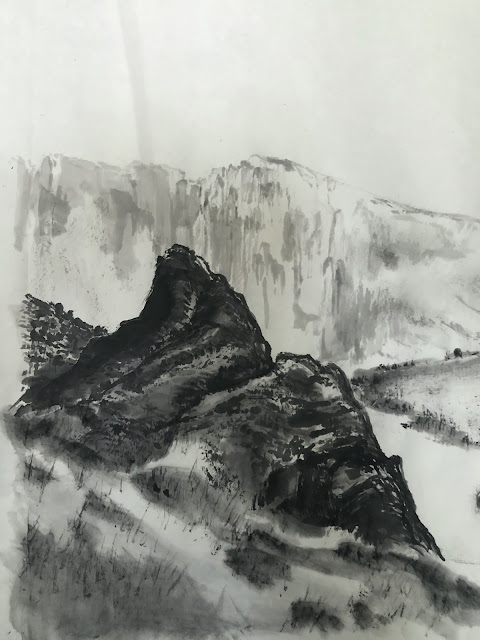After my attempt at painting Chibi (the red cliffs) I want to try my luck on another landscape painting, with cliffs or stony features as my main player; again. Whereas the Chibi painting was sort of dreamy and poetic, I intend for the current production to be more hard and staunch in character.
For this attempt I am mixing my ink with alum solution to paint on traditional Xuan paper. The slight bleeding from the brushstrokes allows the paper the stage to express soft strokes. Alum working as a mordant tends to eliminate that quality by fixing the ink before it has a chance to escape into the microfibers of the paper. I am looking for harsher brushstrokes to help depict the rocky texture of my intended landscape.
My model comes from the central part of Oregon where it is a little less lush with greenery but more abundant with rocky outcrops and mesas. The Deschutes River and the Crooked River are landmarks that inspire me, so I shall use them as my references and give the Columbia River Gorge a pass.
First item on the list is a rocky structure occupying the left side of the painting. I suppose I've not found my rhythms yet and the brushstrokes feel very contrived. Of course the remedy for my shortcoming is to immediately paint the background with diluted ink and loose brushstrokes without the alum as a conspirator, thus the markings are much more relaxed.
Contrasting with the hard edges of the rocky structure are not only the diluted ink for the distant hills, but also the soft non-discrete foreground, as if the camera is out of focus and the viewer is using the bokeh to frame their image in the head.
The center portion of my painting is taken up by the sharp, chiseled rocks of the landscape.
The alum/ink mixtures helps to cement the brushstrokes before they have a chance to bleed; offering a stern appearance.
An assortment of line chuen, akin to the hemp chuen is used to doll up and texturize the non-rocky parts of the landscape. I mean, if Monet and Van Gogh can employ dots and lines to fashion their works, why can't I, right? Actually the dot and line chuen technique has been in practice in Chinese brush techniques since antiquity, I am just making light of them.














